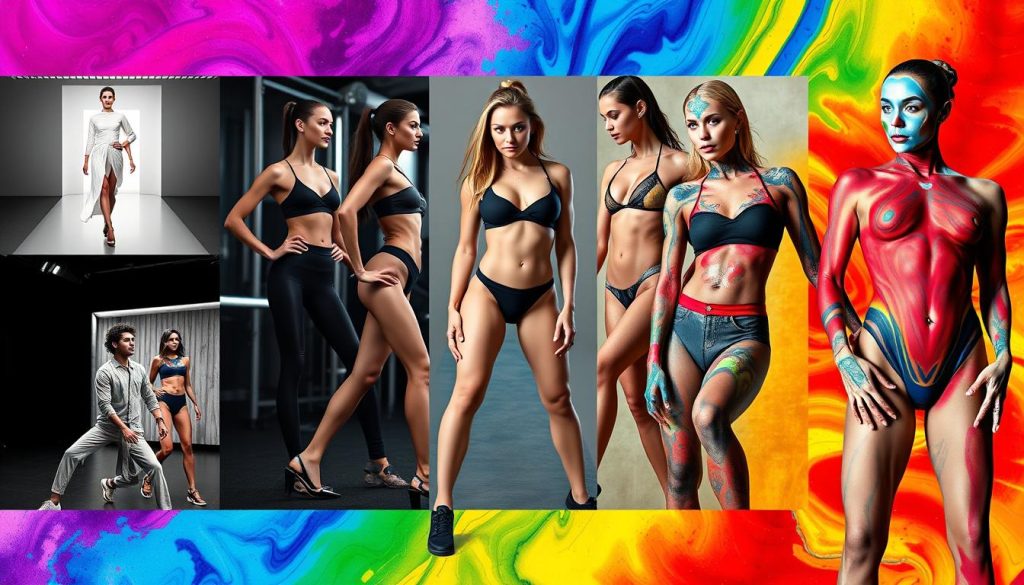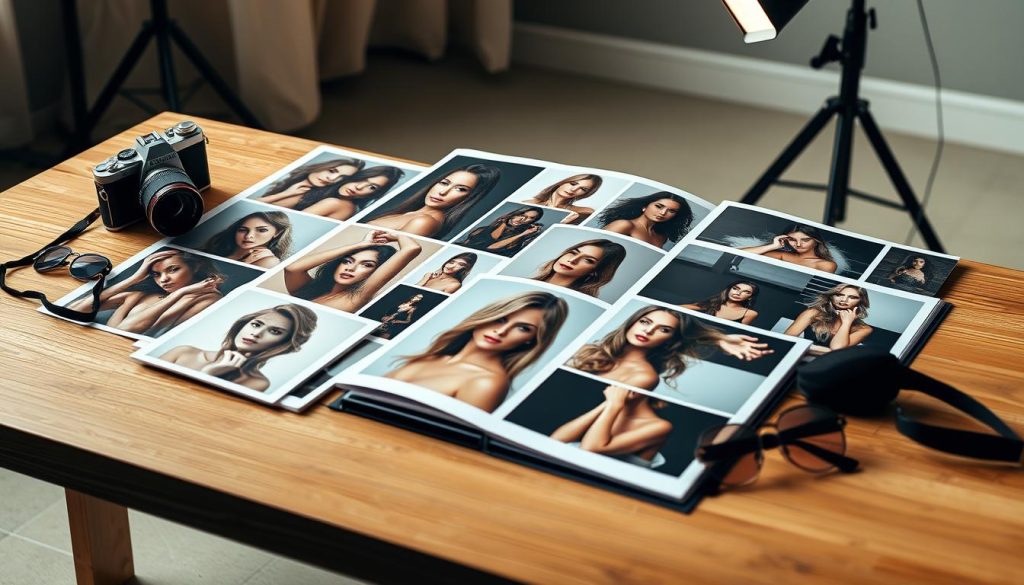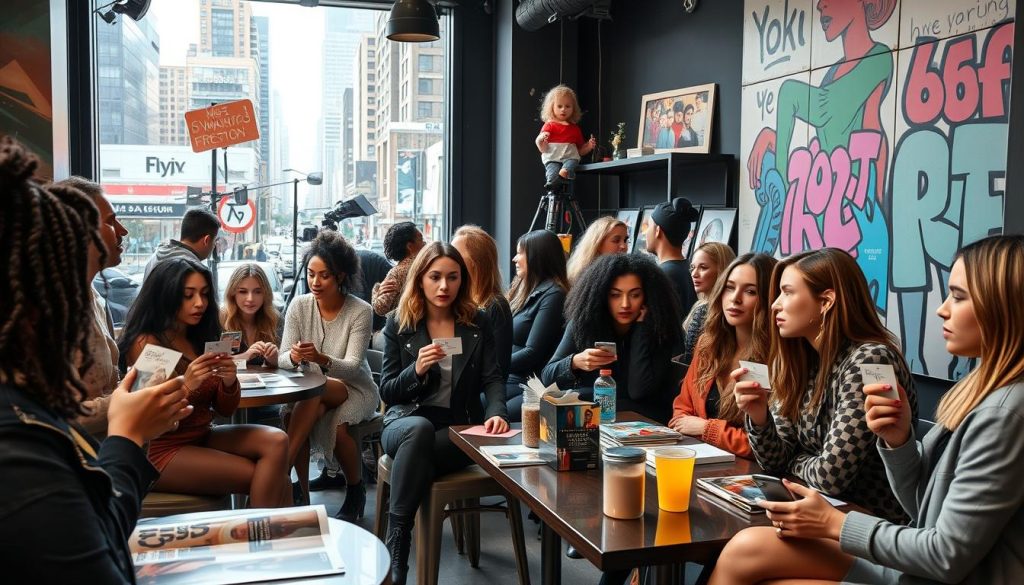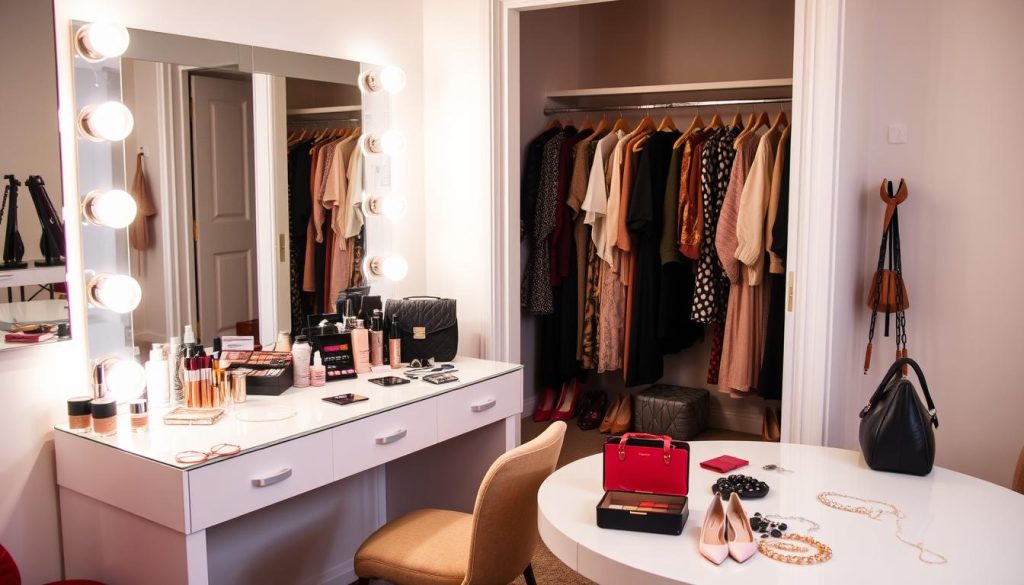Diving into a modelling career might seem like stepping into a fantasy. Yet, it’s actually within reach for those prepared to work hard with zeal and dedication. Remember the first time a glossy magazine spread or a striking advert caught your eye? It made you realize that the modelling world welcomes not just a select few. It’s a realm filled with chances for everyone. To embark on this journey, one needs determination and the readiness to discover what makes them unique.
In Australia, the modelling industry offers various pathways, from commercial gigs to the thrill of strutting down the runway. This field is celebrated for its inclusivity, allowing hopeful models to showcase their true selves and follow their passions. Let us explore how you can start this adventure and make your aspirations a tangible reality.
Key Takeaways
- The modelling industry welcomes individuals with diverse talents and backgrounds.
- Identifying your unique attributes is essential for a successful start.
- Networking plays a crucial role in gaining visibility and opportunities.
- Formal modelling training can enhance your skills and confidence.
- Investing in professional headshots is important for your portfolio.
- Agencies can guide you in navigating the competitive modelling environment.
- Building a diverse portfolio is key to attracting modelling opportunities.
The Modelling Industry Overview
The modelling industry in Australia offers a dynamic and exciting landscape with numerous opportunities. It spans various segments like high fashion, commercial, and plus-size modelling. Each caters to different demographics and needs. There are also niches such as fitness, glamour, and mature modelling. Each provides unique challenges and rewards for those carving out a career in this field.
Networking is crucial in this competitive arena. Building strong relationships with photographers, stylists, and designers is key. Many models participate in Trade for Print (TFP) sessions to build their portfolios with the help of creative professionals. These collaborations are essential for skill enhancement and boosting industry visibility.
Social media is now a key tool for models seeking recognition. Effective use of trending hashtags can significantly raise your profile. A professional portfolio with high-quality images is vital. Emphasizing quality over quantity leaves a stronger impression.
Regarding earnings, modelling rates can greatly differ based on the assignment. Specialised areas like lingerie or bikini modelling often offer higher pay. It’s important for models to keep track of their measurements and maintain a professional look. This highlights the importance of staying physically and mentally healthy. Keeping up-to-date with industry trends and constantly improving skills are crucial for lasting success.
| Niche | Description | Potential Earnings |
|---|---|---|
| High Fashion | Exclusive modelling for runway shows and high-end brands. | Varies; often higher than average. |
| Commercial | Modelling for ads, catalogues, and promotional materials. | Often hourly or day rates; generally moderate. |
| Plus-Size | Focuses on celebrating diverse body shapes. | Competitive; varies widely based on the brand. |
| Fitness | Involves modelling activewear and fitness products. | Competitive; can be lucrative for successful models. |
| Petite | Targets a specific market catering to shorter models. | Variety of rates; generally equal to other niches. |
Grasping the intricacies of Australia’s modelling industry can guide your career effectively. Through dedication and strategic planning, vast opportunities await. This enables the building of a fulfilling modelling career.
Understanding Different Types of Modelling
In the modelling industry, you’ll find various types of modelling. These include fashion, editorial, and commercial modelling. Each type serves different sector demands and appeals to unique audience tastes.
Fashion modelling is quite specific in its requirements. Female models often need to be 5’9″ to 6ft tall, whereas males should be between 5’11” and 6’3″. Age-wise, women are generally 16 to 25, and men fall within the 25 to 40 range. For the runway, being at least 5’8″ for women and 6’0″ for men is usually necessary.
Commercial modelling is more open, lacking strict height or age guidelines. It involves work in ads, catalogues, and commercials. This sector’s diversity means individuals of all ages and sizes can participate. Commercial modelling tends to offer brief, diverse assignments in studio settings, attracting those seeking varied job opportunities.
The editorial category is often distinguished by the high-fashion look, favoring taller and slimmer figures. The industry also boasts niches like fitness modelling, which prizes athletic forms over height, and parts modelling, focusing on individual body parts. Here’s a quick breakdown of these modelling categories:
| Modelling Type | Height Requirements | Typical Age Range | Focus Area |
|---|---|---|---|
| Fashion/Editorial | Females: 5’9″ – 6ft Males: 5’11” – 6’3″ |
Females: 16 – 25 years Males: 25 – 40 years |
High fashion and editorial shoots |
| Commercial | No strict requirements | All ages and body types | Ads, catalogues, commercials |
| Runway | Females: 5’8″ Males: 6’0″ |
Varies; often similar to fashion | Live fashion shows |
| Fitness | No strict height requirement | Varies; inclusivity | Athletic and healthy physiques |
| Parts | No strict requirements | All ages | Specific body parts (hands, feet, etc.) |

How to get started in modelling
Starting your path in modelling may seem daunting, yet a structured approach simplifies it. First, grasp the various modelling types available. This insight helps you zero in on areas you find appealing, such as high-fashion, commercial, or plus-size modelling.
It’s critical to live healthily. Both fitness and clear skin play key roles in the modelling world. Never underestimate personal hygiene; aspects like clean nails and skin are what agencies look for. Highlighting your unique appearance is vital, ensuring your attire and makeup reflect your personal style yet remain versatile.
Building a strong social media presence is a strategic step. Agencies often use platforms like Instagram to find new talent. By keeping your content professional and engaging with the modelling community, you amplify your visibility and connect with valuable contacts, providing exclusive modelling tips for beginners.
Networking plays a crucial role in expanding your reach. Engage in events like Empowered Model to sharpen your skills. It’s crucial to view rejections as milestones towards growth. Persistence, above all, will guide you to your modelling aspirations.
| Modelling Type | Typical Requirements |
|---|---|
| Runway Models | Females: at least 5’8″, Males: 6’0″ |
| Editorial Models | Varied height and body shape, focus on facial beauty |
| Print Models | Work for high-fashion brands like Gucci and Prada |
| Plus-Size Models | Size 12 or over |
| Teen Models | Aged 12-17, requires parental consent |
Identify Your Unique Attributes
Grasping the essence of your unique characteristics can vastly impact your modelling career. Celebrate your distinct facial features, physique, or captivating personal tale to distinguish yourself from others. Such traits not only boost your personal branding but also appeal to clients seeking genuine distinction.
Becoming acutely aware of your individuality bolsters confidence and authenticity in modelling. By understanding your unique selling points, you can effectively promote yourself. Below, explore the various attributes favoured across different modelling niches:
| Type of Modelling | Height Requirements | Typical Age Range | Physical Attributes |
|---|---|---|---|
| Runway | 5’9”-6’0” (female), 6’0” (male) | 16-21 years | Slender build, striking features |
| Fashion | 5’8”-5’11” | 16-21 years | Bust 32”-36”, Waist 22”-26”, Hips 33”-35” |
| Lingerie/Swimsuit | 5’7”-6’0” | 18-25 years | Bust 32”-35” C cup, Waist 22”-26”, Hips 33”-35” |
| Fitness | 5’6” and above | 18-35 years | Well-toned physique |
| 5’8”-5’11” | Varied | Bust 32”-35”, Waist 22”-26%, Hips 33”-35% |
Knowledge of various modelling categories aids in steering your career effectively. All models hold the potential for achievement. Realizing and honing your distinct attributes marks the beginning of seizing more opportunities in a fiercely competitive field.
Finding Your Niche in Modelling
Starting a modelling career involves understanding the diverse niches within the industry. Options include fashion, commercial, fitness, and plus-size modelling. Each niche caters to a unique audience and requires different qualities. Identifying your niche is crucial for a successful career, it lets you leverage your strengths effectively.
Popular Modelling Niches to Explore
Recent years have seen the rise of several modelling niches. Consider these popular choices:
- Runway Modelling: Known for its strict requirements, this niche is both competitive and prestigious.
- Commercial Modelling: This inclusive niche welcomes models of all sizes, appealing to a wide audience.
- Fitness Modelling: Fitness models often use social media to inspire followers towards a healthy lifestyle.
- Plus-Size Modelling: Embracing body positivity, this niche serves a broad customer base, promoting inclusivity.
- Glamour Modelling: This niche captivates through sensuality and allure, focusing on expressive poses.
- Fit Modelling: These models work with designers behind the scenes, ensuring clothing fits and is comfortable.
- Alternative and Tattoo Modelling: Celebrates individuality with unique looks, including tattoos and alternative fashions.
- Art and Conceptual Modelling: Challenges beauty norms with experimental approaches to fashion.
Attributes Needed for Different Modelling Types
Success in modelling hinges on knowing what attributes suit each niche. Each type demands specific characteristics:
| Modelling Type | Key Attributes |
|---|---|
| Runway | Height, body proportions, and confidence |
| Commercial | Versatility and approachability |
| Fitness | Staying fit and living healthy |
| Plus-Size | Embracing body positivity and confidence |
| Glamour | Having sensuality and charisma |
| Fit | Knowing your body and being professional |
| Alternative | Being unique with a bold style |
| Art and Conceptual | Being creative and open to experiments |
Focus on your niche and learn about the attributes needed. Assess your strengths and consider how they match up with the niches. Doing so will smooth your entry into the modelling world, letting you stand out in a competitive field.
Building a Professional Modelling Portfolio
A professional modelling portfolio is like your visual CV in the cutthroat modelling world. It showcases your range and talents, making a powerful first impression essential. High-quality images that show off your versatility are key to drawing in potential clients.
Importance of High-Quality Images
When creating a modelling portfolio, the quality of your images is critical. Aim for 10 to 20 photographs that include:
- Headshots with and without smiles
- Mid-shots and full-body shots
- A variety of wardrobe choices to show different styles
Your portfolio’s photos must be professionally shot and edited to make a memorable impact. Each image should radiate confidence and the ability to switch between various looks and poses. Collaborating with professional hair and makeup artists can enhance your portfolio’s quality.
Creating an Online Portfolio
In today’s world, an online modelling portfolio is vital. It expands your reach and provides easy access for agencies and clients. Your online presence should feature:
- Contact information, including your name, business email, and phone number
- Details like age, height, body measurements, hair, and eye colour
- Social media links for a deeper glimpse into your personality
- A mix of colour and black-and-white photos to showcase versatility
Adding a blog to your online portfolio can offer a personal touch and connect with your audience. A thoughtfully managed online presence helps you catch the eye of prospective clients.

Getting Professional Headshots
For anyone aiming to make a mark in the modelling world, securing top-notch professional headshots is crucial. These images often serve as your first impression and have a significant impact on your career prospects. By hiring a skilled headshot photographer in Australia, you ensure your unique qualities are highlighted effectively.

Your choice of clothing plays a key role in the final look of your headshots. Stick to colours like black, white, gray, or navy for a professional vibe. Using minimal makeup can help accentuate your natural features, making them more prominent. It’s also important to angle your head forward and slightly lower your chin to enhance your jawline.
Listening attentively to your photographer’s guidance is essential for stunning headshots. Meeting up before the shoot or sharing your vision helps in achieving the desired outcome. Picking an appropriate background is crucial too, as it contributes to the overall mood of your headshots.
- Capture crisp and dynamic eyes for added impact.
- Aim for 12-16 essential shots for your portfolio.
- Include full-body shots in various outfits.
- Consider printing your portfolio as a book for open castings.
After securing an agency, it’s wise to create an online portfolio. It’s best to seek critiques from seasoned industry figures, rather than family, to refine your presentation. A varied portfolio, showcasing everything from headshots to full-body images, boosts your appeal. This diversity makes you more noticeable in a crowded marketplace.
Researching Modelling Agencies in Australia
Finding the right modelling agency in Australia is key to effectively launching your career. There are many options available. It’s important to know what to look for to connect with reputable modelling agencies. Begin your research by selecting agencies that match your specific ambitions, whether that’s in fashion, commercial, or editorial modelling. Consider the reputation of these agencies, as it can greatly influence your modelling path.
Identifying Reputable Agencies
To find reputable agencies, keep these tips in mind:
- Seek out agencies with a strong industry presence.
- Explore client testimonials to understand their professionalism and success with previous models.
- Participate in open calls to meet agency representatives in person.
- Focus your search on major cities like Melbourne and Sydney, which offer more opportunities.
Agencies such as Bubblegum Casting, Chadwick Models, GIANT Management, and Pride Models have been praised for their services. Exploring these respected agencies can lead to better informed choices.
Understanding Agency Fees and Contracts
Grasping the details of agency fees and contracts is essential before you agree to anything. Many top modelling agencies in Australia operate on a commission basis, covering initial marketing costs and avoiding upfront fees for models. It’s crucial to thoroughly review contracts, focusing on:
- Commission rates
- Exclusivity clauses
- Contract term
- Expenses involved in building a portfolio
In some scenarios, engaging legal services in city centers can help models understand contract specifics. This knowledge can avoid potential conflicts, ensuring a positive start to your modelling career.

Networking in the Modelling Industry
Building a strong network is crucial in the modelling industry. It enables you to tap into connections that can propel your career. By interacting with photographers, agents, and designers, your chances of landing modelling jobs increase. Establishing a wide range of modelling contacts boosts your prospects significantly.

Attending events such as fashion shows is an excellent way to meet collaborators and clients. These interactions can lead to exciting projects. You’ll gain valuable insights from seasoned professionals. Networking also helps in forming a supportive community with peers, sharing opportunities, and castings.
To maximise your networking efforts, approach each event with genuine curiosity. This fosters meaningful connections. Remember to maintain professionalism and enjoy the social aspect. A balanced approach leaves a lasting impression on industry professionals.
Patience is key in networking. Following up with contacts post-events opens doors for job opportunities. By investing in your network continually, you prepare for a fulfilling modelling career.
Preparing for Casting Calls
Preparing for casting calls is a must for anyone aiming to succeed in modelling. They can greatly influence your future opportunities. Thus, knowing how to prepare properly can boost your chances.

Begin by getting to know the casting call’s specific requirements. Focus on the details provided by the client. This insight will steer your preparation, letting you align your presentation with their expectations. Delve into the client’s history to connect with their brand, showing you grasp their core values.
- Dressing professionally: Choose simple makeup and tailored clothes. This shows your adaptability while respecting the designer’s concept.
- Punctuality is key: Being early demonstrates your professionalism and commitment.
- Follow instructions closely: Be ready to adjust to the client’s audition needs.
- Understand the process of model castings: Prepare for paperwork and possibly group assessments. Be ready to show varied poses and catwalk styles.
An up-to-date portfolio is crucial. It should display your recent looks and diverse abilities. How you present yourself at the casting influences client perceptions. A calm, self-assured demeanor makes a strong impact.
Remember, the competition is stiff, and castings can take time. Maintaining patience and politeness is key.
In conclusion, detailed casting call preparation is vital. It encompasses understanding client needs, dressing right, and arriving on time. These steps significantly improve your odds in modelling castings. Following these tips can set you apart in the modelling industry’s competitive landscape.
Practising Your Modelling Skills
Continuous development is essential in the modelling world. Regular practice of modelling skills sharpens your performance in various settings. Whether tackling runway, editorial, or commercial gigs, learning diverse poses and expressions is crucial. Such preparation not only gears you up for different projects but also boosts your confidence significantly.
Learning Poses and Expressions
Becoming skilled in poses is crucial for any aspiring model. Begin by setting aside time each day to master a range of poses across various modelling streams. Having a repertoire of poses increases your versatility, key in a competitive field. Explore courses that teach posture and poses to grasp body positioning and expression fundamentals. Furthermore, practising facial expressions prepares you for different shoot types, enhancing your adaptability.
Importance of Physical Fitness
Maintaining fitness is vital for models, affecting both appearance and endurance during long workdays starting as early as 5 am. Consistent exercise keeps you in peak condition, meeting industry expectations. Collaborating with trainers helps reach fitness milestones. A balanced diet is equally important for your health. A commitment to fitness increases your chances in fitness modelling, a sector growing with influencer marketing’s popularity.

| Key Aspects of Modelling Skills Practice | Description |
|---|---|
| Daily Posing Practice | Spend at least 10-15 minutes each day refining various poses and expressions. |
| Physical Fitness Regimen | Incorporate a balanced workout routine to stay fit and agile. |
| Classes and Workshops | Attend classes focusing on modelling skills to enhance your expertise. |
| Networking Opportunities | Meet other aspiring models and professionals in the industry to share tips. |
| Feedback and Adjustments | Seek constructive feedback from mentors and peers to improve your practice. |
Creating a routine around these practices not only polishes your modelling skills but also boosts your market appeal. Embrace this journey of ongoing improvement and see your modelling career take off.
Using Social Media to Attract Opportunities
Today’s fashion world demands skillful use of social media from models. Being prominent on Instagram is key. It’s a prime venue to display your modeling prowess and link up with clients and agencies.

Social media engagement is indispensable. Aim to craft content that spurs audience interaction. Strong engagement, seen through likes, comments, and shares, shows audience interest. Set realistic follower growth goals and foster active engagement to start.
Here are vital tips to enhance your online image:
- Optimise your Instagram bio: Ensure it’s succinct. Include relevant hashtags and portfolio urls.
- Showcase your best work: Refine past content and focus on quality to keep your profile sleek.
- Create engaging content: Captivate potential clients with versatile stories, reels, and posts.
TikTok has emerged as a pivotal platform for reaching vast audiences swiftly. Meanwhile, Twitter, or X, promotes industry networking and dialogues. YouTube offers an avenue for content monetisation as your audience expands.
Model scouting initiatives like IMG’s ‘We Love Your Genes’ use hashtags to find new talents. Integrate tags such as #WLYG or #MAKEMEELITE in your posts to enhance your visibility.
Partnering with brands on giveaways or collaborating with influencers can elevate your online visibility. Remember, carving a successful modelling path demands ongoing dedication and an engaging digital footprint. Effectively wielded, social media can unlock numerous modelling opportunities.
Freelancing as a Model
Freelance modelling offers the chance to be independent in your career and explore various modelling gigs. It lets you choose projects that match your interests and talents. This is beneficial for building a diverse portfolio. Independent modelling opportunities often arise through personal connections and outreach to clients.
Platforms like Instagram are crucial for securing modelling gigs. By creating an attractive profile and posting quality images, you’ll attract potential clients. Engaging with your followers through comments and messages boosts your visibility and professionalism.
Though freelance models can pick their projects, connecting with modelling agencies can expand your opportunities. Agencies have connections in fashion and commercial industries. Their reputation helps them secure lucrative projects that might not be available to independents.

However, freelancing poses challenges. Many models struggle for years to get noticed by high-end clients who usually prefer those with agency representation. Though you have freedom, accessing premium opportunities can take time.
It’s beneficial to leverage both freelance opportunities and agency partnerships. Merging independence with professional support offers a balanced career path. An effective strategy enables thriving in freelance modelling while enjoying the advantages of agency connections.
| Characteristic | Freelance Modelling | Agency Representation |
|---|---|---|
| Flexibility | High | Moderate |
| Access to High-End Clients | Limited | Extensive |
| Professional Support | Minimal | Comprehensive |
| Job Variety | Wide | Focused |
| Legal Protection | No | Yes |
In summary, freelance modelling allows you to carve out a unique position in the industry. It offers paths to independent opportunities and modelling gigs, navigating through the challenging yet rewarding modelling landscape.
Maintaining Professionalism in the Industry
In the modelling industry, your professionalism can greatly influence your reputation and future career opportunities. To stand out, it’s vital to grasp and apply proper conduct. By embracing key elements of industry etiquette, you set the stage for a flourishing career.
Long-term success in modelling often goes hand in hand with ethical behaviour, underscoring the value of being reliable, accountable, and striving for excellence. Punctuality, in particular, is crucial. Arriving on time for castings and shoots shows you respect the time of others. It also underscores your dedication to being a professional in the modelling world.
Having strong communication skills is essential for building positive connections with agencies, clients, and other models. As the industry is always changing, models must be adaptable to stay relevant. Formal training can significantly boost these abilities, covering crucial topics such as runway walking, personal grooming, and professional etiquette.
Ethical behaviour helps build trust between you, modelling agencies, and brands. A stellar reputation opens up more opportunities, making your career more rewarding. Take Gigi Hadid as an example: her comprehensive training and professional manner led to remarkable success in modelling.
To wrap up, being punctual, improving communication, and engaging in continuous learning are key to modelling professionalism. These steps prepare you to face the industry’s challenges with confidence.
| Key Attributes of Professionalism | Benefits of Professionalism |
|---|---|
| Punctuality | Builds trust with clients |
| Adaptability | Enhances reputation |
| Effective Communication | Fosters long-term career success |
| Reliability | Encourages repeat bookings |
| Accountability | Strengthens relationships |

Dealing with Rejection and Building Resilience
The modelling industry demands a resilient mindset. Rejection is common, yet it plays a crucial role in your growth. By embracing rejection, you gain the strength to press on and flourish. This journey enhances your mindset, laying the foundation for enduring success.
Accepting Criticism for Growth
Constructive criticism is essential for growth. It sheds light on areas for improvement and your unique strengths. Embracing criticism acceptance allows for skill refinement. This not only bolsters your portfolio but opens doors to new opportunities.
Strategies for Overcoming Rejection
Developing resilience requires practical strategies to tackle setbacks. The following methods are suggested:
- Understand that rejection is not personal but a part of the business.
- Persevere despite the setbacks; each rejection is a step towards success.
- Focus on self-care to keep a balanced emotional state during tough times.
- Acknowledge every small victory to motivate and show your progress.
- Rely on support from loved ones to remain steadfast and encouraged.
By applying these tactics, you build emotional strength. This resilience propels you forward in the modelling world’s dynamic environment.

| Strategy | Description |
|---|---|
| Stay Persistent | Continue applying and auditioning, knowing each rejection is a lesson. |
| Self-Care | Partake in activities that uplift your mental and physical health. |
| Celebrate Achievements | Value each success, small as it may be, as a testament to your effort. |
| Support System | Be around those who offer positivity and motivation. |
A resilient attitude, coupled with accepting feedback, paves the way in modelling. It transforms obstacles into chances for enhancement.
Enjoying the Journey in Modelling
Starting your modelling journey opens doors to creativity and self-discovery. Despite a competitive environment marked by a high rejection rate, every step is a chance for growth. To truly enjoy and find fulfilment in modelling, it’s important to cherish each accomplishment and take lessons from obstacles. This mindset fosters not just career enjoyment but also personal satisfaction.
Being authentic is crucial in a modelling industry filled with demands. Most models shine in the commercial/lifestyle sector, which suggests a more accessible path than the exclusive editorial and runway scenes. Identifying your passion and fitting it within the industry’s needs ensures a fulfilling career. It keeps your view balanced and goal-focused.
Modeling should be seen as more than a pastime—it’s a dedicated pursuit. It demands constant skill enhancement and a zest for new experiences. Your positive approach affects both client relations and your self-esteem. By committing to this journey, you unlock the true joys and successes of modelling, making every moment worth it.


